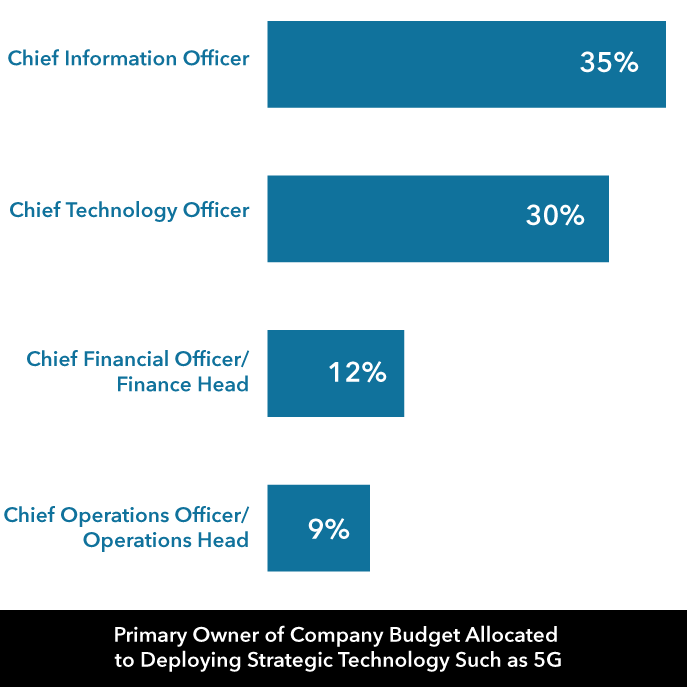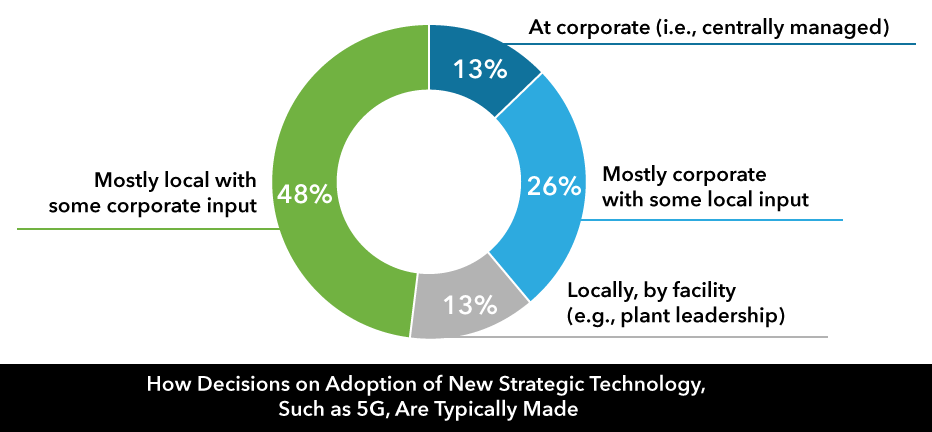Business Impact and Decision Framework
Business Impact
While it’s early in the 5G technology cycle, it’s not too early to start thinking about 5G and how it might impact your manufacturing operations. It’s also important to keep in mind that since 5G standards, technologies, and real-world examples will evolve rapidly over the next few years, that this is an on-going process that should be revisited as new information is available. The decision framework and 5G investment business case will be different for each manufacturer.
Since many 5G industrial deployments are primarily tests or pilot cases so far, solid details on ROI, business value, and approaches are limited. Specific ROI for industrial 5G is difficult to pin down this early, but some companies are sharing projections. While Volkswagen hasn’t broken out 5G financial implications from its projected use of the technology, it has announced additional investments in digital technologies, including 5G, at its main plant in Wolfsburg, Germany. The company is investing €4 billion for agile production, including up to 2,000 new digital jobs and a reduction of 4,000 non-production roles through digitalization, process optimization, and organizational streamlining. The company is also investing €160 million to train its workforce on new analytics and automation technologies. Overall, the company expects a 5% increase in productivity through 2023.
In another study, ABI Research projected that a move to private cellular networks can potentially increase factory and warehouse operations gross margin by 5% to 13%.
And although 5G technologies are still evolving, organizations don’t have to wait to get started on a 5G journey. Since 5G technologies will be used to enable the greater exchange of data and facilities communications, organizations can also start by understanding the role that data plays in their manufacturing operations and the opportunities for better utilization of data sources for manufacturing optimization. Organizations should plan for increased data analysis that will be enabled by 5G (and smart manufacturing initiatives) by getting their data house in order, defining not only what data is currently available within factories but also how it might be used holistically to improve or support the manufacturing process.
Voices on 5G
When trying to determine the business value and impact of an investment in technology like 5G, it’s worth doing a good amount of due diligence. It’s also important to consider all viewpoints, from the more conservative ones that say to hold off on 5G investments until the solutions mature to the more enthusiastic ones that suggest there’s almost unlimited immediate desire for 5G.
To help provide additional context for decisions around the business impact of 5G, and how to make a 5G decision, here’s a selection of viewpoints on 5G from some leading consulting sources:
Capgemini says 5G is an attractive proposition and there is an appetite to launch quickly. According to Capgemini’s report, “5G in Industrial Operations” industrial companies have a significant and immediate appetite for 5G, with two-thirds of industrial companies wanting to implement 5G within two years of its availability. It also projects that one-third of industrial companies would consider applying for 5G licenses, fueled by the belief that private 5G networks offer more autonomy and security, and that telecom operators will be too slow.
Deloitte says the number of 5G pilots happening now is far ahead of its original estimates. Deloitte originally estimated that there would be more than 100 companies worldwide testing private 5G networks by the end of 2020. But that number had been blown out of the water by April and isn’t slowing down because of COVID-19. Deloitte updated its forecast to over 1,000 total 5G private testing deployments by the end of 2020.
Forrester says 5G is a catalyst for automation and process optimization. In its report “The CIO’s Guide to 5G in the Manufacturing Sector” by analyst Dan Bieler, Forrester Research, Inc. states that 5G-enabled infrastructures will support improved process automation as well as production planning and supply chain logistics, but also notes that it’s still too early for industry to deploy 5G for all potential use cases. It also states that nonpublic 5G networks offer new opportunities for smart factories, with more privacy, higher data security, compliance, and better performance.
KPMG says 5G and IoT offer big benefits. KPMG’s report “Converging 5G and IoT: A Faster Path to Smart Manufacturing” highlights the value of combining IoT deployments with a 5G communications infrastructure. It states that 5G networks offer tremendous benefits to manufacturers in terms of data speed, latency, efficiency, reliability, capacity, and security. With the help of 5G networks, IoT platforms will be able to connect discrete point solutions and sensors to monitor entire processes, from R&D all the way to the end of the product lifecycle.
McKinsey & Company sees plenty of B2B 5G and IoT opportunities. In its report , "The 5G Era", McKinsey states that many companies will derive great value from 5G IoT, but it will come in waves. It also notes that with Industry 4.0 B2B opportunities for 5G will abound. It forecasts that Industry 4.0 will account for sales of about 22 million 5G IoT units in 2030, with most applications related to manufacturing.
Owners and Stakeholders
As one might expect of technology innovation, the MAPI survey also revealed that the top two strategic decisionmakers were also the ones who own budgets that can be allocated to technologies such as 5G.
CIOs and CTOs are the primary budget and decision owners.

Source: 2020 MAPI Next-Generation Connectivity Survey
The primary decision makers are most often the CIO or CTO.

Source: 2020 MAPI Next-Generation Connectivity Survey
However, when it comes to adopting new technologies such as 5G, the respondents to the MAPI survey said that relatively few decisions to invest in new strategic technologies for connectivity in the manufacturing environment were centrally managed. Instead, decisions are typically made predominantly at the local level (48%), followed by decisions mostly made at the corporate level with some local input (26%).
Companies depend on local strategic technology decisions.

Source: 2020 MAPI Next-Generation Connectivity Survey
Decision Framework
To accelerate organizational readiness to act with confidence, consider the following framework:
1: Identify
Identify strategic manufacturing goals and the role of connectivity in them. What smart factory initiatives is your company pursuing? Are you considering broad-scale IoT deployment? Are your customers pushing for your organization to IoT-enable your products? Do you plan on increasing the use of artificial intelligence or machine learning in your manufacturing? Are there opportunities for the use of augmented reality?
All of these (and other goals) can drive a significant increase in the need for data movement, communication services, and wireless connectivity like 5G.
2: Assign
Assign a cross-function business and operations working group to study 5G and understand its applications. It’s hard to make an informed decision without information, and many manufacturing organizations have limited insights into 5G’s current status and future potential. That’s why it’s important for manufacturing organizations to define a responsible party or team to research 5G capabilities and track 5G developments while considering corporate goals. It’s also important to understand 5G’s current release and the functionality that future releases will deliver. For example, the current version of 5G, Release 15, provides a good baseline for future 5G plans, and can be used effectively for specific use cases (such as augmented reality or high-quality video), but real industrially-oriented capabilities for deploying tens of thousands of sensors or time-sensitive networking will arrive in future releases.
3: Focus
Focus efforts on specific tactical and strategic 5G opportunities. With 5G’s breadth, there are many ways to start considering its implications for industrial uses. One place might be to consider deploying it as a fixed wireless connection for any remote corporate sites or scenarios where existing connectivity is lacking. Although it may be early, organizations should also consider possibilities for using 5G connectivity for connected products or services, as well as how it might IoT-enable products. Last, but not least, organizations should identify how 5G might be used to support existing and future shop floor needs.
4: Evaluate
Evaluate 5G alternatives and the cost of waiting. Today, 60% of executives agree that 5G benefits are still unproven but 69% indicate benefits will be worth the cost of adoption! Will existing industrial wireless solutions work? Will WiFi or WiFi 6 provide adequate capabilities? Perhaps a 4G LTE private network will fulfill most of what’s needed, or simply waiting until standards, products, or practices mature enough to provide a stronger ROI for a 5G investment. “You don’t need to wait for 5G Release 16,” said Erik Josefsson, Global Head of Advanced Industries, from Ericsson. “You can get a lot of value from deploying an end-to-end 4G system, getting reliability and stability, and then upgrade to 5G in the future.”
5: Right-size
Right-size your 5G investments. For many manufacturing organizations, it may be too early to build a business case for 5G. Instead, initial investments may need to be considered as research and development or pilot cases until technology solutions, sales models, and the business case is more mature.
6: Review
Review your decisions. 5G isn't a product, it's a process that will unfold over the next decade. Manufacturers embarking on the 5G journey should strap in for the long haul and set up processes for regularly reviewing and revising 5G decisions and plans.
Go-To 5G Resources
ISA – The International Society of Automation is a non-profit professional association of engineers, technicians, and management engaged in industrial automation.
3GPP – The 3rd Generation Partnership Project (3GPP) was created to help define the 3rd generation of mobile communications but has also led the definition of the subsequent versions, including 5G.
5G-ACIA – The 5G Alliance for Connected Industries and Automation (5G-ACIA) was created to ensure the applicability of 5G for industrial uses, including discrete and process manufacturing.
5G Americas – 5G Americas is an industry organization that facilitates and advocates for the advancement and transformation of LTE, 5G and beyond throughout the Americas.
Communications technology vendors – Most of the communications technology vendors have lots of 5G resources on their websites, including Ericsson, Nokia, and Qualcomm.
Technology vendors – A number of technology vendors, such as Intel have extensive 5G resources.
Return to Next-Generation Connectivity Main Page | Continue to Implementation: Build, Buy, or Partner?
